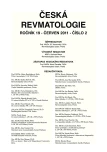How to regard structural progression in biological therapy?
Authors:
L. Šenolt
Authors‘ workplace:
Revmatologický ústav, Praha
Published in:
Čes. Revmatol., 19, 2011, No. 2, p. 77-79.
Category:
Posts from Congress
Overview
Structural progression of rheumatoid arthritis manifests as joint space narrowing and development of bone erosions on X-ray images. On conventional therapy structural progression is a manifestation of disease activity, and is usually directly proportional to long-term functional disability. During the first years of the disease irreversible joint involvement often develops. Structural progression occasionally occurs even in patients in clinical remission. Biological therapy, on the other hand, can completely suppress radiographic progression even if certain signs of inflammatory activity are present. Thus, in the assessment of efficacy of biological therapy we have to consider the dissociation between clinical and radiographic findings. Bone reparation has been described in rare cases. In patients treated with biological therapy a low disease activity is acceptable, however, on treatment with synthetic agents, maximum reduction of synovitis and absence of clinically detectable form of the disease should be the therapeutic aim.
Key words:
biological therapy, radiographic progression, remission, inflammatory activity, rheumatoid arthritis
Sources
1. Smolen JS, Aletaha D, Bijlsma JW, et al. T2T Expert Committee.Treating rheumatoid arthritis to target: recommendations of an international task force. Ann Rheum Dis 2010; 69: 631-7.
2. Machold KP, Stamm TA, Nell VP, et al. Very recent onset rheumatoid arthritis: clinical and serological patient characteristics associated with radiographic progression over the first years of disease. Rheumatology (Oxford) 2007; 46: 342-9.
3. Brown AK, Quinn MA, Karim Z, et al. Presence of significant synovitis in rheumatoid arthritis patients with disease-modifying antirheumatic drug-induced clinical remission: evidence from an imaging study may explain structural progression. Arthritis Rheum 2006; 54(12): 3761-73.
4. Molenaar ET, Voskuyl AE, Dinant HJ, Bezemer PD, Boers M, Dijkmans BA. Progression of radiologic damage in patients with rheumatoid arthritis in clinical remission. Arthritis Rheum 2004; 50(1): 36-42.
5. Smolen JS, Han C, Bala M, Maini RN, Kalden JR, van der Heijde D, et al. ATTRACT Study Group. Evidence of radiographic benefit of treatment with infliximab plus methotrexate in rheumatoid arthritis patients who had no clinical improvement: a detailed subanalysis of data from the anti-tumor necrosis factor trial in rheumatoid arthritis with concomitant therapy study. Arthritis Rheum 2005; 52(4): 1020-30.
6. Breedveld FC, Weisman MH, Kavanaugh AF, Cohen SB, Pavelka K, van Vollenhoven R, et al. The PREMIER study: A multicenter, randomized, double-blind clinical trial of combination therapy with adalimumab plus methotrexate versus methotrexate alone or adalimumab alone in patients with early, aggressive rheumatoid arthritis who had not had previous methotrexate treatment. Arthritis Rheum 2006; 54(1): 26-37.
7. Smolen JS, Han C, van der Heijde DM, Emery P, Bathon JM, Keystone E, et al. Active-Controlled Study of Patients Receiving Infliximab for the Treatment of Rheumatoid Arthritis of Early Onset (ASPIRE) Study Group. Radiographic changes in rheumatoid arthritis patients attaining different disease activity states with methotrexate monotherapy and infliximab plus methotrexate: the impacts of remission and tumour necrosis factor blockade. Ann Rheum Dis 2009; 68(6): 823-7.
8. van der Heijde D, Landewé R, van Vollenhoven R, Fatenejad S, Klareskog L. Level of radiographic damage and radiographic progression are determinants of physical function: a longitudinal analysis of the TEMPO trial. Ann Rheum Dis 2008; 67(9): 1267-7.0
9. Cohen SB, Keystone E, Genovese MC, Emery P, Peterfy C, Tak PP, et al. Continued inhibition of structural damage over 2 years in patients with rheumatoid arthritis treated with rituximab in combination with methotrexate. Ann Rheum Dis 2010; 69: 1158-61.
10. Genant HK, Peterfy CG, Westhovens R, et al. Abatacept inhibits progression of structural damage in rheumatoid arthritis: results from the long-term extension of the AIM trial. Ann Rheum Dis 2008; 67: 1084-9.
11. Kremer JL, Blanco R, Brzosko M, et al. Tocilizumab inhibits structural joint damage in rheumatoid arthritis patients with inadequate responses to methotrexate at 1 year: The LITHE study. Arthritis Rheum 2010 Nov 19. [Epub ahead of print]
12. Emery P, Durez P, Dougados M, et al. Impact of T-cell costimulation modulation in patients with undifferentiated inflammatory arthritis or very early rheumatoid arthritis: a clinical and imaging study of abatacept (the ADJUST trial). Ann Rheum Dis 2010;69:510-6.
13. Schett G, Rudwaleit M. Can we stop progression of ankylosing spondylitis? Best Pract Res Clin Rheumatol 2010; 24: 363-71.
14. DŅhn UM, Ejbjerg B, Boonen A, et al. No overall progression and occasional repair of erosions despite persistent inflammation in adalimumab-treated rheumatoid arthritis patients: results from a longitudinal comparative MRI, ultrasonography, CT and radiography study. Ann Rheum Dis 2010. [Epub ahead of print]
Labels
Dermatology & STDs Paediatric rheumatology RheumatologyArticle was published in
Czech Rheumatology

2011 Issue 2
Most read in this issue
- Treatment with biological drugs in special situations (pregnancy, lactation, vaccination and surgery)
- Extraarticular manifestations of rheumatic diseases and the possibilities of their alleviation by biological therapy
- Biological therapy of rheumatoid arthritis and the risk of tumorous diseases
- Occurrence of infections under treatment with TNF alpha antagonists in ATTRA registry
